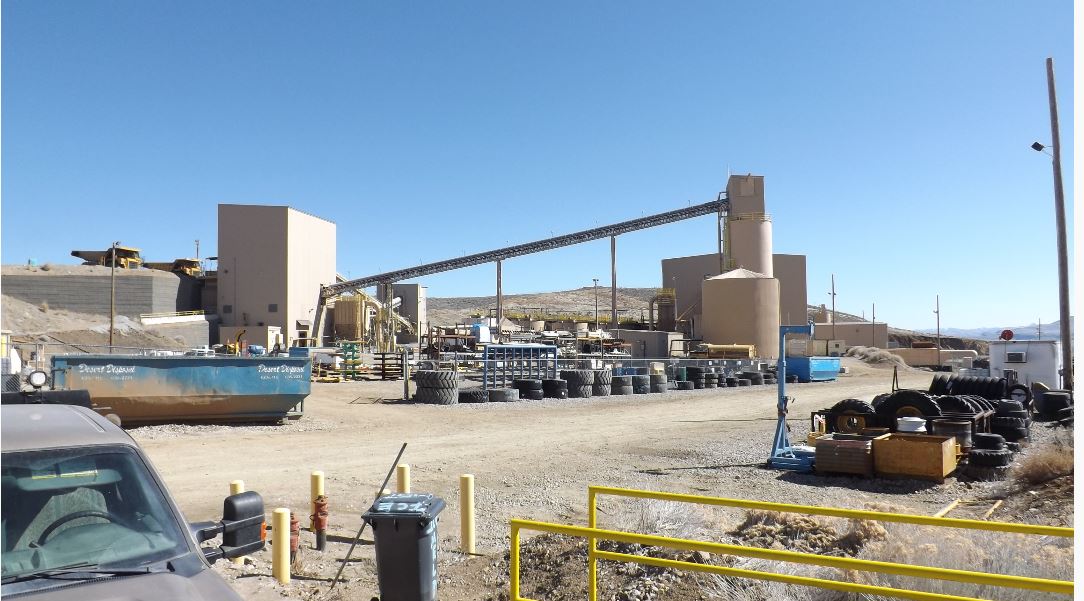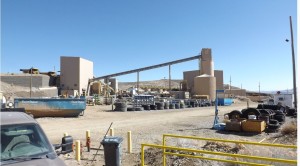Klondex Mines reports Nevada high-grade gold assays

The Klondex Mines Midas mill between Elko and Reno, northern Nevada. Source: Klondex Mines Ltd.

Klondex Mines Ltd. [KDX-TSX; KLDX-NYSE MKT] is providing an update on surface drilling at its Fire Creek and Midas mines, both 100%-owned and located in northern Nevada, USA. The following drill results are in addition to those included within the mineral resources released on September 16, 2015 and mineral reserves released on December 3, 2015.
Fire Creek Project drilling highlights:
- FCC-0014: 0.40 oz/ton gold over 3.2 feet, or 13.90 g/t over 1.0 metre (East Zone);
- FCC-0014: 0.31 oz/ton gold over 1.7 feet, or 10.79 g/t over 0.5 m (East Zone);
- FCC-0035: 3.11 oz/ton gold over 1.0 foot, or 106.49 g/t over 0.3 m (updip);
- FCC-0030: 0.10 oz/ton gold over 35.6 feet, or 3.34 g/t over 10.6 m (South Zone);
including 0.32 oz/ton gold over 1.2 feet, or 10.94 g/t over 0.4 m;
including 0.21 oz/ton gold over 2.2 feet, or 7.10 g/t over 0.7 m.
Midas Mine — Trinity Zone drilling highlights:
- DMC-300: 0.27 oz/ton AuEq over 10.0 feet, or 9.08 g/t over 3.05 m (Trinity);
- DMC-301: 2.47 oz/ton AuEq over 2.5 feet, or 84.67 g/t over 0.8 m (Trinity);
- DMC-302: 9.37 oz/ton AuEq over 5.0 feet, or 321.28 g/t over 1.5 m (Trinity).
Fire Creek Mine
A total of 13 surface holes totaling 20,386 feet (6,214 m) were drilled during the second half of 2015. These holes were targeting the Eastern expansion, Northwest expansion, South expansion and updip of the vein system in the current mine area (see table on the company’s website).
Eastern expansion
Three exploration holes were drilled approximately 2,000 feet (609.6 m) east of the current workings at Fire Creek. These holes tested a geophysical anomaly that extends approximately 19,000 feet (4,267.2 m) in length. Two of these holes successfully intercepted the target suggesting a major mineralized structure could exist. A follow-up drill program is scheduled for later in the year.
Northwest expansion
Five holes were drilled in the Northwest expansion area. These holes were designed to extend the vein system along strike, upgrade the resource within the current model and test for paralleling vein structures west of the modelled resource. Drill hole FCC-0041A intersected a new structure to the west containing anomalous gold mineralization values up to 0.18 ounce per ton. The area remains open in all directions.
Southern expansion
An additional offset hole, FCC-0030, was drilled for a total of four holes to build and support the southern extension target. These holes suggest that mineralization continues for at least another approximate 330 feet (100.6 m) south of the current resource. These drill results suggest that this wide zone of mineralization continues to the south and potentially presents bulk-mining scenarios at Fire Creek.
Updip expansion
Four holes were drilled updip of the modelled vein system at Fire Creek. These holes intersected mineralization outside the existing resource and extend known veins updip more than 250 feet (76.2 m). These holes were drilled from surface between zero degree and six degrees, and suggest the vein system likely extends within 250 feet from surface.
Midas Mine
At Midas, five holes were drilled targeting the Trinity zone for a total footage of 5,641 feet (1,719.4 m). This drilling was designed to extend the mineralized footprint to the south and to better define the controls to the higher-grade mineralization in the system (see table on the company’s website).
Brian Morris, Vice-President, Exploration, said, “The results from our December 2015 surface drilling program are very encouraging. We have gained an increased understanding of the vein system at Fire Creek based on the positive results from this phase of surface drilling. At Midas, not only do we continue to extend the mineralized footprint in the Trinity zone, but the data suggests that the contact between the breccia and the overlying Esmeralda sediments is an important control for the high-grade mineralization within the Trinity gold system.”
